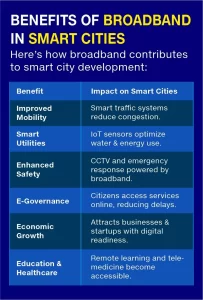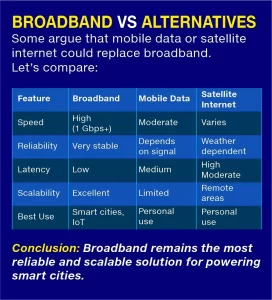Smart Cities & Broadband: Building the Urban Future
The future of cities is no longer defined just by skyscrapers and highways; it’s defined by connectivity. In the age of smart cities, broadband has become the backbone that supports digital transformation, efficient governance, and enhanced quality of life. From intelligent traffic systems to IoT-powered homes, reliable broadband is the invisible infrastructure driving it all.
In this blog, we’ll explore:
- What smart cities and broadband mean in 2025–2026.
- Why broadband is critical for urban development.
- Benefits, challenges, and best practices.
- Real-world applications and future trends.
What Are Smart Cities?
A smart city is an urban area that leverages digital technology, IoT (Internet of Things), and data-driven governance to improve the quality of life for citizens.
Key Features of Smart Cities:
- Connected Infrastructure: Roads, utilities, and services linked via sensors.
- Efficient Governance: Data-driven decisions for public services.
- Sustainability: Energy-efficient systems reducing carbon footprint.
- Citizen-Centric: Better healthcare, education, and safety.
Simply put, smart cities are about making urban life more efficient, sustainable, and inclusive with technology.
What Role Does Broadband Play in Smart Cities?
Broadband is the digital nervous system of a smart city. Just as roads move cars, broadband moves data.
Why Broadband Matters in Smart Cities:
- Enables real-time communication between IoT devices.
- Provides ultra-fast connectivity for citizens and businesses.
- Supports cloud-based governance systems.
- Powers AI-driven analytics for smarter decision-making.
Without broadband, a smart city cannot function — it would be like a city without electricity.
Benefits of Broadband in Smart Cities

Pros of Broadband in Smart Cities
- Seamless integration of technology.
- Encourages innovation and entrepreneurship.
- Improves citizen satisfaction and safety.
Cons (Challenges)
- High infrastructure cost.
- Data security risks.
- Unequal access in underdeveloped areas.
Broadband vs Alternatives

Best Practices for Smart Cities Using Broadband
To ensure maximum efficiency, cities should follow these best practices:
- Invest in Fiber Optics: Fiber provides unmatched speed and reliability.
- Public-Private Partnerships: Encourage collaboration between governments and ISPs.
- Cybersecurity Frameworks: Protect sensitive citizen data.
- Inclusive Access: Ensure affordable internet for all citizens.
- Scalable Infrastructure: Build networks that can grow with demand.
- Smart Policies: Create legal frameworks for data usage, AI, and IoT.
Common Mistakes & Myths
Mistakes Cities Make:
- Ignoring rural integration (leading to digital divide).
- Overlooking cybersecurity in data collection.
- Focusing only on tech without considering citizens’ needs.
Myths About Broadband in Smart Cities:
- Myth: 5G will replace broadband.
- Truth: 5G complements broadband but cannot fully replace fiber networks.
- Myth: Broadband only benefits internet users.
- Truth: It powers transport, healthcare, governance, and safety systems.
Real-World Examples of Smart Cities Using Broadband
- Singapore: Uses broadband-powered IoT to manage energy and transport.
- Barcelona: Smart lighting and waste management reduce costs.
- Delhi NCR (India): Moving toward smart governance with digital broadband initiatives.
FAQs
1. What is the role of broadband in smart cities?
Broadband powers IoT devices, cloud platforms, and smart governance making cities efficient and sustainable.
2. Can mobile data replace broadband in smart cities?
No. Mobile data is useful for individuals, but it cannot handle the scalability and low-latency demands of smart cities.
3. How does broadband improve quality of life in cities?
It enables smart healthcare, digital education, efficient transport, and safer environments.
4. What are the biggest challenges of broadband in smart cities?
The main challenges are infrastructure cost, cybersecurity, and equitable access.
5. What is the future of broadband in urban development?
Future smart cities will rely on fiber optics, AI-driven analytics, and 6G-ready networks.
Conclusion
Smart cities are no longer a futuristic dream they are becoming a reality. And at the center of this transformation lies broadband. From powering IoT devices to enabling digital governance, broadband is the foundation of sustainable urban growth.
As we step into 2025–2026, cities that invest in robust broadband infrastructure will lead the way in creating smarter, safer, and more connected urban environments.



